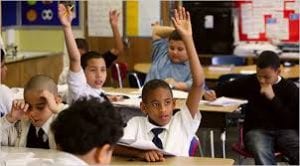According to The Atlantic, 34 single-gender schools became operated in 2004. Ten years later that number has jumped, According to The New York Times, in 2014 850 schools nationwide became single-gender schools. Which is a big jump in just ten years. When I think of single-gender school I cannot relate. I’ve been in a coed school From pre-school all the way until now in college. I have never thought of going to an all-girls school. But I knew someone who was in an all-girls school, and a teacher that taught at an all-girls school. When talking to her about it one day she told me how the girls do so much better and excel in their education by just being in a school of their same gender. It made sense to me, growing up in schools sometimes guys can intimate you or you get scared to ask a question because you’re scared you will sound dumb in front of the boy. I’ve had this experience many times. Same-sex schools work, But how?
A hypothesis that many believe in is that, males and females brains are wired differently, the way their brain functions and develops are not alike. Boys struggle behind girls when it comes to testing and reading. Also, boys have a higher chance of facing disciplinary problems in the future than girls. I think this has an effect on education. If you have mixed genders in class and the boys fools around or give the teacher a problem it stops the learning and just causes distractions. Reading this from an article made me think. I know that when I was in school, girls always seemed to be more mature than the boys were. Knowing this I was able to relate that to how boys and girls are wired differently in the way they learn. It makes sense, Girls might absorb information in a different way than boys just by how much more mentally mature they are.
When looking at the statistics of single-gender schools vs. Coed schools. In 2010 78% of students graduated from a coed school. 82% of students graduated from a single gender school. The numbers aren’t far apart but it definitely says something. When it comes to standardizing testing, there is no surprise that many students don’t do well. In a coed school, 37% of the students had a reasonable test score. In single-gender schools, 86% of the students had a reasonable test school. There is a big jump in those numbers. Which has to mean that single-gender schools are beneficial. It is not surprising that more people are having their kids go to a single gender school because they think that is going to benefit them to excel in their education. But there are always people who disagree.
The New York Times interviewed a group of individuals about this topic. While a good amount of people thought that this was a good idea, a woman names Ms. Bigler stated ‘ You say there is a problem with sexism and instead of addressing sexism, you just remove one sex. Reading that made me think and in a way I do agree with what she has to say. It’s like sweeping the problem under the rug. But the focus of having single-gender schools is not about the sexism but about the opportunity to excel more in education.
There is also an issue that boys struggle behind girls when it comes to testing and reading. Also, boys have a higher chance of facing disciplinary problems in the future than girls. I think this has an effect on education. If you have mixed genders in class and the boys fools around or give the teacher a problem it stops the learning and just causes distractions. I have had this many times throughout my years in school. And it goes make a difference when you are trying to learn something and pay attention. It has been proven children become easily distracted when in a classroom with the opposite gender. Especially when it comes to high school. There are a lot of hormone changes going on in girls and guy and emotions everywhere. It all becomes a gid distraction from why the reason you’re actually in school, to learn.
I think girls will most likely benefit from single-gender schools than boys would. Single gender schools are not a bad thing. Like anything else in life, there are pros and cons. But when it comes to education and your future I think the best thing is to go with what is going to make you learn the best way and have a higher chance of succeeding in. On whether I think it is a good thing or bad thing. I’ve never been in a single gender school I’ve always been in a mixed gender school. I do think that maybe if I was in one it would’ve helped me academically a lot more. But I don’t think that would be for me.





